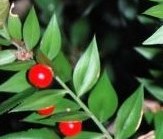 Butcher’s broom, also known by many other common names including knee holly, is a low growing broadleaf evergreen shrub native to the Mediterranean and western Europe. The thick, glossy, dark green structures that appear to be leaves are actually modified stems called cladophylls. They have spines on their tips and bear the flowers and fruits. The true leaves are microscopic. Tiny, greenish-white male and female flowers are usually produced singly or in pairs on separate plants in spring and female flowers produce attractive waxy red berries in late summer and fall. Flowers containing both male and female parts are sometimes produced but if berries are wanted both male and female plants should be planted. Butcher’s broom is tolerant of a variety of soils, is drought tolerant, and does well in part to full shade. It is an excellent choice for a wooded area and makes an attractive hedge. In the florist trade the greens are known as Italian Ruscus and are extensively used in wedding work.
Butcher’s broom, also known by many other common names including knee holly, is a low growing broadleaf evergreen shrub native to the Mediterranean and western Europe. The thick, glossy, dark green structures that appear to be leaves are actually modified stems called cladophylls. They have spines on their tips and bear the flowers and fruits. The true leaves are microscopic. Tiny, greenish-white male and female flowers are usually produced singly or in pairs on separate plants in spring and female flowers produce attractive waxy red berries in late summer and fall. Flowers containing both male and female parts are sometimes produced but if berries are wanted both male and female plants should be planted. Butcher’s broom is tolerant of a variety of soils, is drought tolerant, and does well in part to full shade. It is an excellent choice for a wooded area and makes an attractive hedge. In the florist trade the greens are known as Italian Ruscus and are extensively used in wedding work.
Type: Broadleaf, evergreen shrub
Outstanding Features: Shade tolerance, foliage
Form: Mound
Growth Rate: Slow to bulk up
Bloom: Tiny, 1/16″ across, greenish white male and female flowers are produced on cladophylls in spring.
Size: 2-3′ H x 2-3′ W
Light: Part to full shade
Soil: Average, medium moist, well-drained; drought tolerant when established
Care: Cut out dead stems at the base in spring
Hardiness: Zones 7-9
Pests and Diseases: None of significance
Propagation: Division; seed needs stratification and may take over a year to germinate
Outstanding Selection: ‘Wheeler’ (self-fruiting).
